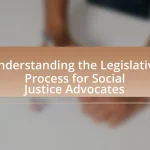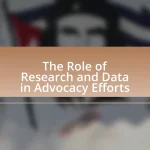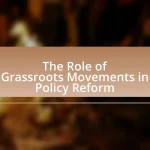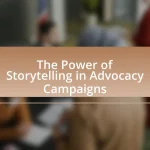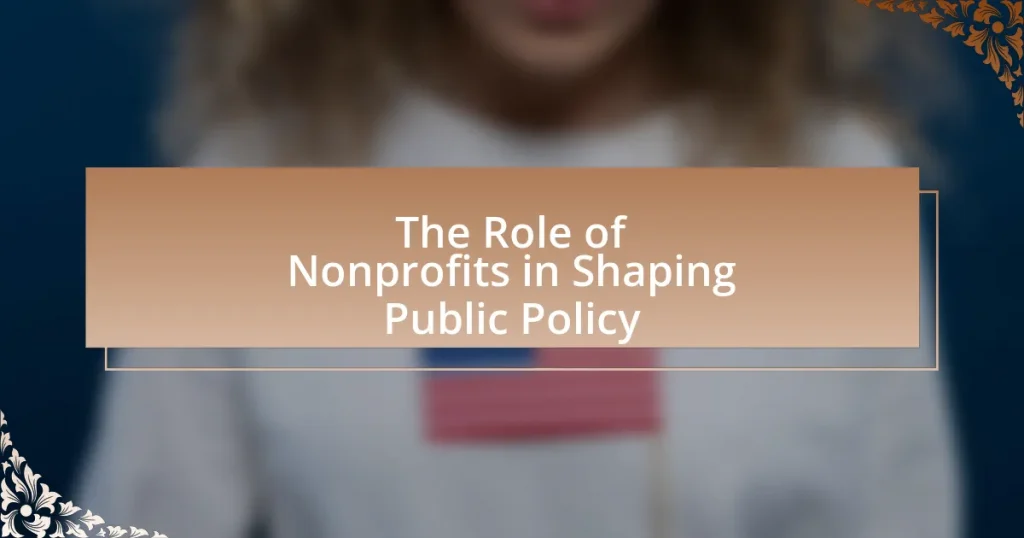Nonprofits play a vital role in shaping public policy by advocating for social change, influencing legislation, and mobilizing community engagement. They utilize strategies such as grassroots mobilization, coalition building, and lobbying to represent marginalized communities and ensure diverse voices are heard in policymaking. The article explores how nonprofits collaborate with government entities, the challenges they face, and the unique perspectives they bring to policy discussions. It also highlights successful nonprofit-led initiatives and best practices for enhancing advocacy efforts, emphasizing the importance of data-driven strategies and effective communication in influencing public policy.
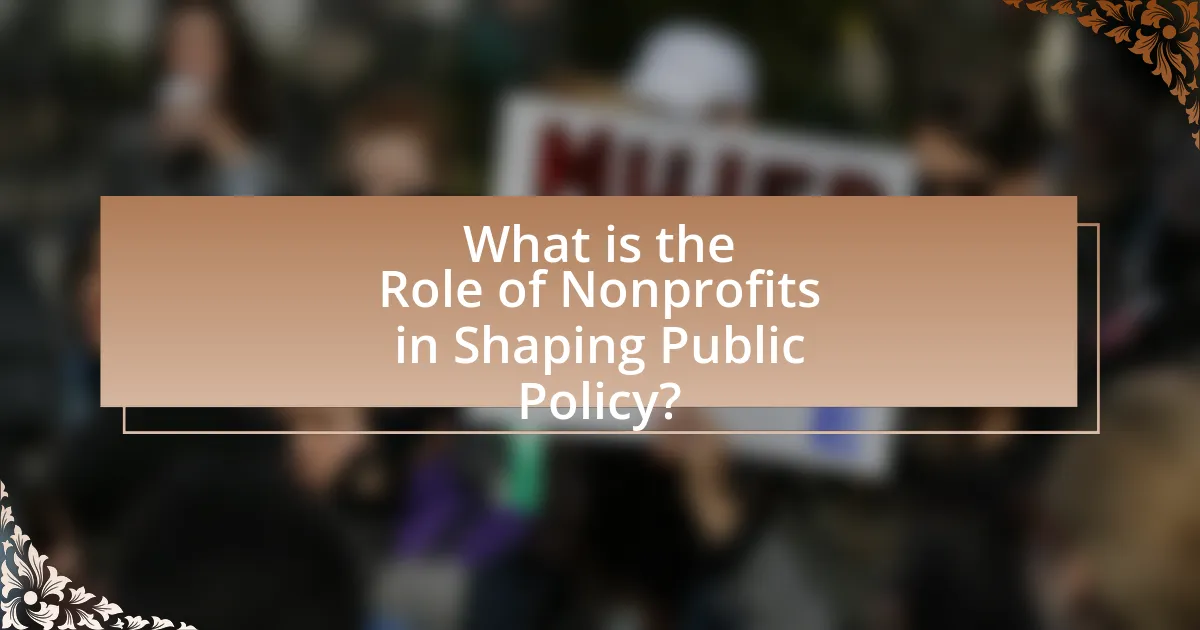
What is the Role of Nonprofits in Shaping Public Policy?
Nonprofits play a crucial role in shaping public policy by advocating for social change, influencing legislation, and mobilizing community engagement. They often conduct research, provide expert testimony, and engage in lobbying efforts to represent the interests of marginalized groups. For instance, organizations like the American Civil Liberties Union (ACLU) have successfully influenced policy changes regarding civil rights through strategic litigation and public campaigns. Additionally, nonprofits often serve as a bridge between the government and the community, facilitating dialogue and ensuring that diverse voices are heard in the policymaking process. This multifaceted involvement underscores the significant impact nonprofits have on shaping policies that affect various aspects of society.
How do nonprofits influence public policy decisions?
Nonprofits influence public policy decisions primarily through advocacy, lobbying, and public education efforts. These organizations mobilize resources to raise awareness about specific issues, engage in direct lobbying of lawmakers, and build coalitions to amplify their voices. For instance, the National Wildlife Federation has successfully lobbied for environmental legislation, demonstrating how nonprofits can shape policy outcomes by providing expertise, mobilizing public support, and influencing legislators. Research indicates that nonprofits contribute significantly to policy discussions, with studies showing that 70% of policymakers consider nonprofit input valuable when making decisions.
What strategies do nonprofits use to advocate for policy changes?
Nonprofits utilize various strategies to advocate for policy changes, including grassroots mobilization, coalition building, lobbying, and public awareness campaigns. Grassroots mobilization involves engaging community members to participate in advocacy efforts, which can amplify voices and demonstrate public support for specific issues. Coalition building allows nonprofits to unite with other organizations to strengthen their influence and resources, making their advocacy efforts more impactful. Lobbying involves direct interaction with policymakers to persuade them to support specific legislation or regulations, often backed by research and data to substantiate their positions. Public awareness campaigns aim to educate the general public and raise awareness about critical issues, thereby creating pressure on policymakers to act. These strategies are supported by evidence showing that organized advocacy efforts can lead to significant policy changes, as seen in various successful campaigns for social justice, environmental protection, and healthcare reform.
How do nonprofits collaborate with government entities?
Nonprofits collaborate with government entities through partnerships, funding agreements, and advocacy efforts. These collaborations often involve nonprofits providing services or expertise that complement government initiatives, such as community outreach programs or specialized knowledge in areas like health and education. For example, the National Council of Nonprofits highlights that many nonprofits receive government grants to implement programs that align with public policy goals, thereby enhancing service delivery and community impact. Additionally, nonprofits often engage in advocacy to influence policy decisions, working alongside government officials to address social issues and promote legislative changes. This synergy not only helps in resource sharing but also fosters a more comprehensive approach to addressing community needs.
Why are nonprofits important in the public policy landscape?
Nonprofits are important in the public policy landscape because they advocate for marginalized communities and influence policy decisions. By representing diverse interests, nonprofits provide essential data and insights that inform lawmakers, ensuring that various perspectives are considered in the policymaking process. For instance, according to a report by the National Council of Nonprofits, nonprofits contribute to public policy discussions by mobilizing grassroots support and conducting research that highlights social issues, which can lead to legislative changes. This role enhances democratic participation and accountability in governance.
What unique perspectives do nonprofits bring to policy discussions?
Nonprofits bring unique perspectives to policy discussions by representing marginalized communities and advocating for social justice. Their grassroots connections enable them to identify specific needs and challenges faced by these communities, which are often overlooked in traditional policy-making processes. For instance, nonprofits frequently conduct research and gather data on issues such as poverty, healthcare access, and education disparities, providing evidence-based insights that inform policy decisions. Additionally, nonprofits often serve as intermediaries between the public and government, facilitating dialogue and ensuring that diverse voices are included in the policy-making process. This role enhances the democratic process by promoting transparency and accountability in governance.
How do nonprofits represent marginalized communities in policy-making?
Nonprofits represent marginalized communities in policy-making by advocating for their interests, amplifying their voices, and providing critical data to inform policy decisions. These organizations often engage in grassroots mobilization, ensuring that the perspectives of underrepresented groups are included in discussions that affect their lives. For instance, nonprofits like the National Urban League and the NAACP have historically influenced legislation by conducting research that highlights disparities faced by marginalized populations, thereby providing lawmakers with evidence-based recommendations. Additionally, nonprofits often collaborate with coalitions to strengthen their advocacy efforts, ensuring that the needs of marginalized communities are prioritized in policy agendas.
What challenges do nonprofits face in shaping public policy?
Nonprofits face significant challenges in shaping public policy, primarily due to limited financial resources and political influence. Many nonprofits operate on tight budgets, which restricts their ability to engage in extensive lobbying or advocacy efforts. According to the National Council of Nonprofits, over 70% of nonprofits report that funding constraints hinder their ability to influence policy effectively. Additionally, nonprofits often struggle with navigating complex regulatory environments that govern lobbying activities, which can limit their engagement in policy discussions. Furthermore, competition for attention and resources among various advocacy groups can dilute their impact, making it difficult for nonprofits to assert their priorities in the public policy arena.
How do funding limitations impact nonprofit advocacy efforts?
Funding limitations significantly hinder nonprofit advocacy efforts by restricting their ability to conduct outreach, mobilize resources, and implement programs. Nonprofits often rely on grants and donations to fund their initiatives; when these financial resources are limited, they face challenges in raising awareness, influencing policy changes, and engaging stakeholders effectively. For instance, a study by the National Council of Nonprofits found that 75% of nonprofits reported that funding constraints directly impacted their capacity to advocate for policy issues, leading to reduced visibility and diminished influence in legislative processes.
What legal restrictions affect nonprofit involvement in politics?
Nonprofit organizations face specific legal restrictions regarding their involvement in politics, primarily governed by the Internal Revenue Code. Section 501(c)(3) prohibits these organizations from participating in any political campaign on behalf of or in opposition to any candidate for public office. Additionally, while nonprofits can engage in lobbying activities, the extent is limited; they must not exceed a certain percentage of their overall expenditures, which is defined under the “substantial part test” or the “expenditure test.” Violating these restrictions can result in the loss of tax-exempt status and potential penalties.
How do nonprofits measure their impact on public policy?
Nonprofits measure their impact on public policy through a combination of quantitative and qualitative assessments. They often utilize metrics such as changes in legislation, shifts in public opinion, and the extent of community engagement to evaluate their influence. For instance, a nonprofit advocating for environmental policy may track the number of new laws passed that align with their goals, as well as conduct surveys to gauge public awareness and support for these initiatives. Additionally, case studies and reports documenting specific policy changes attributed to their advocacy efforts serve as concrete evidence of their impact.
What metrics are used to evaluate nonprofit advocacy success?
Metrics used to evaluate nonprofit advocacy success include policy changes, public awareness levels, coalition building, and stakeholder engagement. Policy changes are often measured by the number of legislative or regulatory outcomes influenced by the nonprofit’s efforts, demonstrating direct impact on public policy. Public awareness levels can be assessed through surveys or media coverage, indicating how effectively the nonprofit has communicated its message. Coalition building is evaluated by the number and strength of partnerships formed, which can enhance advocacy efforts. Lastly, stakeholder engagement is measured through participation rates in advocacy campaigns, reflecting the mobilization of community support. These metrics provide a comprehensive framework for assessing the effectiveness of nonprofit advocacy initiatives.
How can nonprofits improve their effectiveness in policy influence?
Nonprofits can improve their effectiveness in policy influence by building strategic coalitions with other organizations and stakeholders. Collaborative efforts amplify their voice and resources, enabling them to present a united front on policy issues. For instance, the Coalition for the Homeless in New York City successfully influenced housing policy by partnering with various advocacy groups, resulting in increased funding for homeless services. Additionally, nonprofits should invest in data-driven advocacy, utilizing research and statistics to support their positions, as evidenced by the American Civil Liberties Union’s use of legal data to shape criminal justice reform. Engaging in grassroots mobilization also enhances their influence, as seen in the success of environmental nonprofits that mobilized public support for climate legislation.
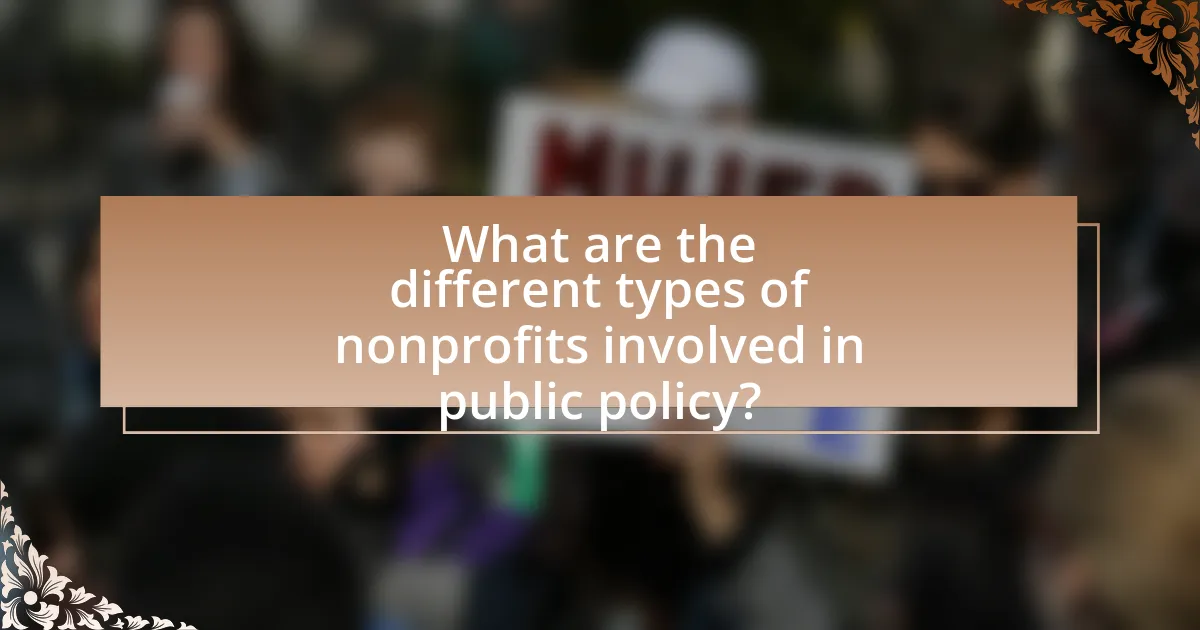
What are the different types of nonprofits involved in public policy?
Different types of nonprofits involved in public policy include advocacy organizations, think tanks, service organizations, and grassroots groups. Advocacy organizations, such as the American Civil Liberties Union, focus on influencing legislation and public opinion on specific issues. Think tanks, like the Brookings Institution, conduct research and provide policy recommendations to inform decision-makers. Service organizations, such as the United Way, address social issues while also engaging in policy discussions to improve community outcomes. Grassroots groups mobilize community members to advocate for change at the local level, exemplified by organizations like MoveOn.org. Each type plays a distinct role in shaping public policy through research, advocacy, and community engagement.
How do advocacy nonprofits differ from service nonprofits?
Advocacy nonprofits focus on influencing public policy and social change, while service nonprofits primarily provide direct services to individuals or communities. Advocacy organizations engage in activities such as lobbying, public education, and mobilizing citizens to promote specific causes or policy changes, exemplified by groups like the American Civil Liberties Union, which works to protect civil rights through legislative advocacy. In contrast, service nonprofits, such as food banks or shelters, deliver essential services and support to meet immediate needs, emphasizing direct assistance rather than policy influence. This distinction highlights the different missions and methods employed by these types of nonprofits in their efforts to impact society.
What roles do think tanks play in shaping public policy?
Think tanks play a crucial role in shaping public policy by conducting research, providing expert analysis, and offering policy recommendations to government officials and the public. They influence decision-making processes through the dissemination of data-driven insights and innovative solutions to complex societal issues. For instance, the Brookings Institution, a prominent think tank, has been instrumental in shaping economic policy through its rigorous studies and reports that inform lawmakers and stakeholders. Additionally, think tanks often engage in advocacy efforts, mobilizing public opinion and fostering dialogue around specific policy issues, thereby enhancing democratic participation and accountability.
How do grassroots organizations mobilize community support for policy change?
Grassroots organizations mobilize community support for policy change by engaging local residents through education, advocacy, and coalition-building. These organizations often conduct outreach programs to inform the community about specific issues, fostering awareness and understanding of the policy implications. For instance, the National Domestic Workers Alliance successfully mobilized support for the Domestic Workers Bill of Rights by organizing workshops and community meetings that highlighted the challenges faced by domestic workers. Additionally, grassroots organizations leverage social media platforms to amplify their messages, reaching a broader audience and encouraging community members to participate in advocacy efforts. This approach has been effective in generating public support, as evidenced by the increased participation in campaigns that led to significant policy changes in various states.
What are some examples of successful nonprofit-led policy initiatives?
Successful nonprofit-led policy initiatives include the American Civil Liberties Union’s (ACLU) advocacy for civil rights, which has led to significant legal reforms, including the legalization of same-sex marriage in various states. Another example is the work of the Sierra Club in promoting environmental legislation, such as the Clean Air Act amendments, which have resulted in improved air quality standards. Additionally, the National Network to End Domestic Violence has successfully influenced policies that enhance protections for survivors of domestic violence, leading to the establishment of the Violence Against Women Act. These initiatives demonstrate the impactful role nonprofits play in shaping public policy through advocacy and legal action.
How did a specific nonprofit achieve a significant policy change?
A specific nonprofit achieved a significant policy change by mobilizing grassroots advocacy and leveraging data-driven research to influence lawmakers. For instance, the American Civil Liberties Union (ACLU) successfully campaigned for criminal justice reform by presenting compelling evidence of racial disparities in sentencing. This evidence was drawn from comprehensive studies, such as the “Report on Racial Disparities in Sentencing” published in 2018, which highlighted systemic biases. The ACLU’s strategic partnerships with community organizations further amplified their message, leading to the passage of legislation aimed at reducing mandatory minimum sentences in several states.
What lessons can be learned from successful nonprofit campaigns?
Successful nonprofit campaigns demonstrate the importance of clear messaging and community engagement. Effective campaigns often utilize targeted communication strategies that resonate with their audience, ensuring that the mission and goals are easily understood. For instance, the American Cancer Society’s “Great American Smokeout” effectively raised awareness about smoking cessation through a focused message and community involvement, leading to significant participation and impact. Additionally, successful campaigns leverage data and storytelling to create emotional connections, as seen in the “Ice Bucket Challenge,” which raised over $220 million for ALS research by combining social media engagement with a compelling narrative. These examples illustrate that clarity, community involvement, and emotional resonance are key lessons learned from successful nonprofit campaigns.
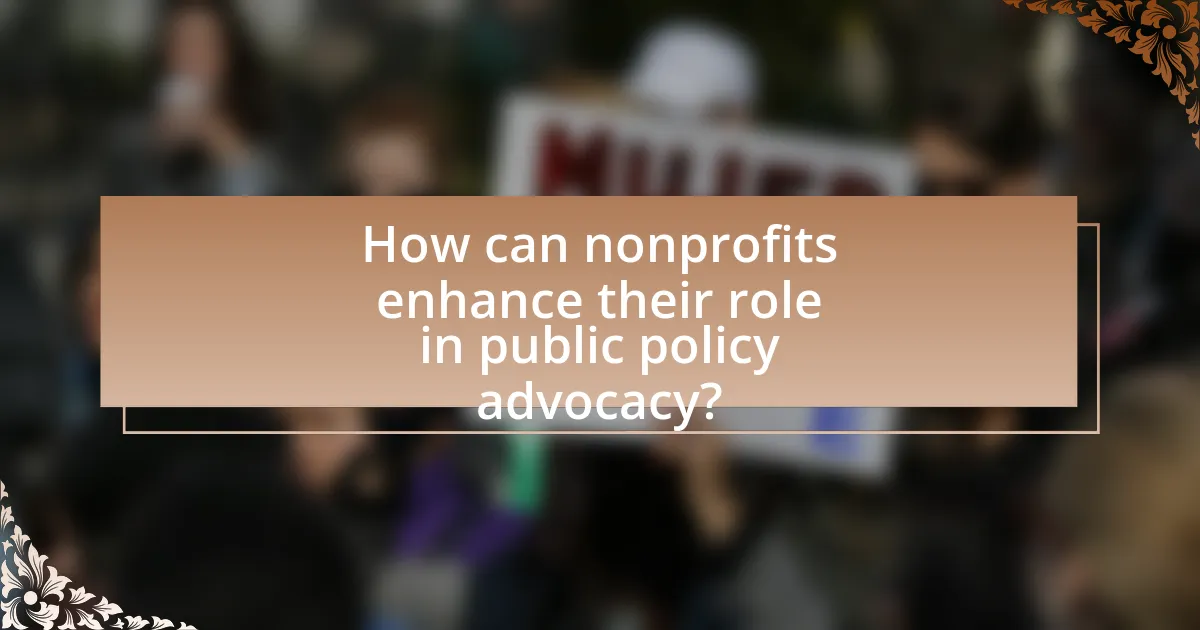
How can nonprofits enhance their role in public policy advocacy?
Nonprofits can enhance their role in public policy advocacy by building coalitions with other organizations to amplify their voice and influence. Collaborative efforts allow nonprofits to pool resources, share expertise, and present a united front on policy issues, which can lead to more significant impact. For instance, the National Council of Nonprofits highlights that coalitions can effectively mobilize public support and engage stakeholders, thereby increasing the likelihood of policy change. Additionally, nonprofits can leverage data and research to inform their advocacy efforts, ensuring that their positions are backed by evidence, which strengthens their credibility in policy discussions.
What best practices should nonprofits follow for effective advocacy?
Nonprofits should follow best practices such as building strong coalitions, engaging in grassroots mobilization, and utilizing data-driven advocacy for effective advocacy. Strong coalitions enhance influence by uniting diverse stakeholders, as seen in successful campaigns like the American Cancer Society’s collaboration with various health organizations to promote cancer research funding. Grassroots mobilization empowers community members to advocate for change, exemplified by the success of the Women’s March, which galvanized millions to advocate for women’s rights. Data-driven advocacy, supported by research from the Urban Institute, demonstrates that nonprofits using evidence-based strategies can significantly increase their impact on policy decisions.
How can nonprofits build coalitions to strengthen their influence?
Nonprofits can build coalitions to strengthen their influence by strategically aligning with like-minded organizations to amplify their collective voice. This collaboration allows nonprofits to pool resources, share expertise, and enhance advocacy efforts, thereby increasing their impact on public policy. For instance, the National Council of Nonprofits highlights that coalitions can effectively mobilize diverse stakeholders around common goals, leading to more robust lobbying efforts and greater visibility in policy discussions. By leveraging the strengths of each member organization, nonprofits can create a united front that is more persuasive to policymakers and the public.
What communication strategies are most effective for nonprofits in policy advocacy?
Effective communication strategies for nonprofits in policy advocacy include storytelling, data-driven messaging, coalition building, and targeted outreach. Storytelling engages audiences emotionally, making complex issues relatable and memorable. Data-driven messaging provides credible evidence to support advocacy positions, enhancing the argument’s legitimacy; for instance, a study by the Pew Research Center found that data can significantly influence public opinion and policymaker decisions. Coalition building allows nonprofits to amplify their voices by partnering with other organizations, thereby increasing their reach and impact. Targeted outreach ensures that messages are directed to specific stakeholders, such as legislators or community leaders, maximizing the chances of influencing policy outcomes.
What resources are available for nonprofits to improve their policy engagement?
Nonprofits can access various resources to enhance their policy engagement, including advocacy training programs, policy toolkits, and networking opportunities. Organizations like the National Council of Nonprofits provide comprehensive resources, including guides on effective advocacy strategies and best practices for engaging with policymakers. Additionally, platforms such as the Alliance for Justice offer training sessions and webinars focused on nonprofit advocacy and lobbying laws, ensuring that nonprofits understand their rights and responsibilities. Research indicates that nonprofits that utilize these resources are more effective in influencing public policy, as evidenced by case studies demonstrating successful advocacy campaigns led by trained organizations.
How can nonprofits access training and support for advocacy efforts?
Nonprofits can access training and support for advocacy efforts through various organizations and resources dedicated to capacity building. These include national organizations like the Alliance for Justice, which offers training programs and resources specifically designed for nonprofit advocacy, and the National Council of Nonprofits, which provides guidance on effective advocacy strategies. Additionally, many local community foundations and nonprofit associations offer workshops and seminars that focus on advocacy skills, legal compliance, and strategic communication. These resources are essential for nonprofits to enhance their advocacy capabilities and effectively influence public policy.
What tools can nonprofits use to track policy developments and engage stakeholders?
Nonprofits can use tools such as policy tracking software, social media platforms, and stakeholder engagement applications to monitor policy developments and engage stakeholders effectively. Policy tracking software like Quorum and FiscalNote allows organizations to stay updated on legislative changes and relevant policy issues by providing real-time alerts and comprehensive databases. Social media platforms, including Twitter and Facebook, enable nonprofits to communicate directly with stakeholders, share updates, and mobilize support for advocacy efforts. Additionally, stakeholder engagement applications like Mobilize and NationBuilder facilitate outreach and relationship-building with constituents, ensuring that nonprofits can effectively gather feedback and foster community involvement. These tools collectively enhance the ability of nonprofits to influence public policy and maintain active engagement with their stakeholders.
